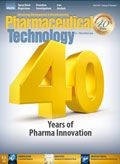Continuous API Manufacturing
Industrial-scale continuous API manufacturing may offer cost and safety benefits.
A growing number of companies around the world are using continuous processes to make small-molecule APIs. “There’s more potential for continuous with APIs, just from a cost standpoint, than for drug product,” says Kevin Nepveux, vice-president of global technology services at Pfizer, which is taking a hybrid, or case-by-case approach to continuous API and oral solid dosage (OSD) form manufacturing.
“There is a lot of value to using continuous to telescope API steps and replace traditional steps that are bottlenecks or safety risks,” he says. “And you can do a lot of chemistry in flow cells that you wouldn’t want to do in a batch environment, just for safety and process control reasons.” One application would be flow hydrogenation for catalytic hydrogenations, while opportunities also exist in continuous crystallization and drying, he says.
The need for safer API production is driving demand for industrial-scale continuous chemical reactors, says Yi Jiang, global business director, Corning Reactor Technologies, which has developed continuous Advanced Flow Reactor (AFR) products for use in API and fine-chemical manufacturing.
Corning began developing the technology in 2002 and has improved it, Jiang says, to the point where, compared with traditional batch reactors, AFR reactors can enable at least 100 times enhancement in mixing and 1000 times improvement in heat transfer performance, allowing operating cost reductions of 30-40%. “Continuous flow technology has redefined reactor productivity,” says Jiang, “so that it is no longer based on volume of output, but on how effectively the chemical is processed.” Continuous also speeds up and simplifies API scale up, just as it does for OSD.
Corning’s AFR has been recognized as an inherently safer technology (IST), says Jiang, and Corning has been seeing increased demand for the technology, particularly in China. The Chinese government has mandated increased chemical reactor safety since 2016, when a major explosion at one facility in Tianjin killed more than 160 people.
Recent years have seen growing worldwide demand for industrial-scale APR equipment, says Jiang. In October 2016, the API manufacturer Angelini Pharma, installed an industrial-scale AFR reactor at its facility in Aprilia, Italy (1). Demand is particularly strong in India and China, which are producing more of the world’s APIs. AFR is installed at the top 10 API manufacturers’ facilities in India, says Jiang. “There is a clear need for inherently safer technology which will continue to drive growth, but in a greener way that reduces environmental impact,” Jiang says.
Could end-to-end take off in developing markets?
Where integrated facilities might not always make economic sense in the United States and Western Europe, there are questions about whether end-to-end continuous processing facilities might take off in developing markets. A number of countries are requiring that more drug substance be developed onshore and integrated with drug product manufacturing.
Dave Di Prospero, director of pharmaceutical process technology at CRB USA and cofounder of the International Society of Pharmaceutical Engineers (ISPE)’s OSD Community of Practice, recalls Kalbio Medika, an Indonesian company that won honorable mention at ISPE’s 2017 Facility of the Year awards program for its new biopharma API facility (1). Even though the facility manufactures biopharmaceuticals and is not completely continuous, the reasons for its design reflect Indonesia’s goals to have more of its pharmaceutical supply chain located on shore. Indonesia manufactures 70% of its fiinished drugs, but still imports 90% of raw materials, and the government wants its drug manufacturers to make more ingredients onshore, says Di Prospero.
Reference
1. ISPE, Honorable Mentions, 2017 Facility of the Year Awards, February 2017,
Article Details
Pharmaceutical Technology
Vol. 41, No. 7
Page: 52
Citation
When referring to this article, please cite it as A. Shanley, “Continuous API Manufacturing,” Pharmaceutical Technology 41 (7) 2017.

Drug Solutions Podcast: A Closer Look at mRNA in Oncology and Vaccines
April 30th 2024In this episode fo the Drug Solutions Podcast, etherna’s vice-president of Technology and Innovation, Stefaan De Koker, discusses the merits and challenges of using mRNA as the foundation for therapeutics in oncology as well as for vaccines.
Drug Solutions Podcast: Applying Appropriate Analytics to Drug Development
March 26th 2024In this episode of the Drug Solutions Podcast, Jan Bekker, Vice President of Business Development, Commercial and Technical Operations at BioCina, discusses the latest analytical tools and their applications in the drug development market.
Pharmaceutical Tariffs Are Imminent: How Industry is Bracing for Impact
April 16th 2025On April 14, 2025, the Trump Administration launched a national security-driven investigation into pharmaceuticals, a move that will likely result in tariffs being placed on pharmaceutical drugs, ingredients, and other components that are imported from outside of the United States.
